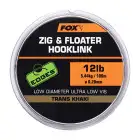This is a demo store. No orders will be fulfilled.
Fishing Mainlines: An Important Decision - with Chris de Clercq

In this blog, Chris takes us through a number of factors that he takes into consideration when choosing his fishing mainline.
Anyone who limits their mainline choice to a standard nylon 35/00 mainline for every conceivable angling scenario, really sells themselves short nowadays. Every reputable manufacturer will have a wide range of mainlines in their collection, and with good reason. I’m very flexible when it comes to my mainline choices and it fully depends on the angling situation I’m in.
Monofilament Lines
The classic nylon, an advanced copolymer or the robust fluorocarbon: what all these lines have in common, is that they consist of one type of material and look like the classic fishing line: smooth with a fair amount of stretch. Yet they do have a variety of characteristics which we can definitely use to our advantage. A light, and I’m talking about density here, nylon line is very suitable to use as a floater line or zig line when you use smaller diameters. With a floater line you’ll be able to present your hookbait in a very natural way in this specific situation.
See Fox Zig and Floater Line
Copolymer Lines
When it comes to copolymer lines, I like to use a very special type of line: the tapered mainline. This is a thin, smooth 300m long mainline that has a seamless, slightly thicker, a tapered bit of about 15m at both ends. The thicker ends allow you to absorb the force of casting over extremely long distances, whilst eliminating the need for a shock leader knot. Once you’ve started your cast, the thin, smooth line will effortlessly run off the spool and allow you to easily reach distances of 150m or more. This is the line to use if you’re casting across exceptionally long distances.
Fluorocarbon Lines
Fluorocarbon mainlines are a class of their own: they are virtually invisible underwater, very heavy and extremely abrasion resistant thanks to the hardness of the material. Unfortunately, these pros also bring with them a few cons: these lines aren’t very suitable for casting across great distances due to their rigidness. Moreover, the high sink rate might contribute to a less accurate bite detection. However, I do like to use this line when bank fishing because it’ll sit nicely on the river- or lake bed. Alternatively, I like to use these lines in clear water during the winter months as a shock leader in combination with a braid.

Braids
Braided mainlines, or braids, have seen some great development over the past decade. Not only have they become much smoother and rounder, the use of extra fibres means that these lines are extremely durable and abrasion-resistant too. Moreover, you can get them in both floating or sinking variants. A good quality braid will easily last you a few years, which compensates for the higher price compared to a mono. The biggest advantage of a braided mainline is that there is no stretch in them whatsoever. In my opinion, this is only advantageous:
Advantages of Fishing with Braid
1) The first advantage is the incredible sensitivity you’ll experience during the sinking and landing of your lead after you’ve cast your rod. With a bit of practice and experience, you’ll immediately know what type of bottom you’re dealing with: rocky or soft, sand or mud, with or without weeds. The correct interpretation of the type of bed allows you to better tailor your rig or bait presentation to the situation, leading to better catches!
2) A second big advantage of a stretchy braid applies to long-distance fishing and obstacle fishing. The bite indication is always immediate, no matter the distance, and an added bonus is that a carp can’t use the stretch to swim into an obstacle. You, therefore, have full control over a fleeing fish, and you can use your rod to lead the fish away from any danger.
3) The third advantage is that a sinking braid allows you to fish with a slackline, without losing out on its excellent bite detection. No more tight lines running through your spot that’ll immediately alert the resident carps that something’s not quite right. An absolute game-changer at heavily fished venues.
With all those benefits it won’t come as a surprise that a sinking braid is my pick for the vast majority of angling situations. Fox' Submerge Sinking Braided Mainline is one of those lines, which, thanks to its smoothness, is a joy to cast. It is available in 3 editions: I like to use the 25lbs when I want to cast far and without many obstacles; the 40lbs is a nice all-around size that lends itself well for locked up obstacle fishing. For extreme tough conditions, such as large French reservoirs or lakes, your best option is the tough big brother with an impressive breaking strain of 55lbs!
What is the Best Mainline for Fishing?
Make sure you give the recent mainline developments a chance in your angling. A braid or fluorocarbon line might take a bit of getting used to at first, but you’ll soon find out that using the right line under the right circumstances pays off. Picking a suitable mainline for a specific angling style will certainly make the hours you spend on the bank way more efficient. You’re angling more sensitively, precisely, further and stronger than ever before and that’ll only result in better catches. Think about it!



